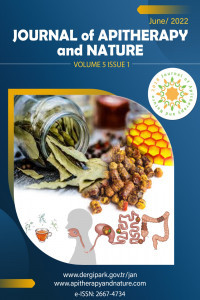The Antihelminth Effect and Economic Efficiency of Clover and Absinth
The Antihelminth Effect and Economic Efficiency of Clover and Absinth
Antihelminthic effect, economic efficiency, clover absinth,
___
- Adilov, T. A. (1970). Harmful and alkaloid plants of Uzbekistan, Tashkent. Antihelmint-antihelmint medicine, (82-124).
- Aliyev, N., Guliyev, K. H., & Ibragimov, G. (1971). Antimicrobe influence of the ether oils of some plants. Heraclum. J from Azerbaijan/Plant resource/LT.YII, 1, 85-88.
- Berezekina, S. V., & Demidov, N. V. (1979). Antihelmint properties of some plants. Bulletin VIGIS, 2, 8-11.
- Damir, I. A., Prilipko, L. I., Shukurov, D. E., & Kerimov, Y. B. (1988). The medicine plants of Azerbaijan (pp. 304). Baku: Maariph.
- Eminov, R. Sh. (1982). Episotoology of the trikhostrongylesia and osteratagiose of the sheep in the regions of the south foothills of Big Caucasus of Azerbaijan SSR and efficiency of some medicine plants during the invasions (Master thesis). Available from Candidate of Veterinary Science.
- Hajiyev, Y. G., & Eminov. R. Sh. (1986). The influence of the medical plants to the method of the stomach-intestine tracts of the sheep. Bulletin VIGIS, 44, 12-16.
- Hajiyev, Y. G., & Maharramov, S. H. (1996). The antihelmint efficiency of Peganium harmala. Azerbaijan Agrarian Science, 1(2), 65-66.
- Hajiyev, Y. G. (2000). The evaluation of the economical efficiency in Helmintose. Azerbaijan Agrarian Science, 1(2), 66-70.
- Maharramov, S. G. (2000). The antihelmint efficiency against stomach-intestine tract of the sheep. Agrarian Science of Azerbaijan, 1(2), 70-80.
- Maharramov, S. H. (2001). Antihelmint medicine plants of Nakhchevan AR, The Autonomic Republic of Nakhchevan, Natural resources and the ways of the efficient use (pp. 56-57). Nakhchevan, Geyrat.
- Maharramov, S. G. (2002). The evaluation of economy efficiency against worms in Farmer Economies. The development problems of the entrepreneurship and small-scale business (pp. 42-44).
- Mammadov, A. G., Hajiyev, Y. H., Shirinov, N. M., & Agayev, A. A. (1986). Veterinary-parasitology (pp 428). Baku: Azerneshr.
- Maharramov, S. H. (2008). The embrotype influence against of Chashir-Ajligotu mixture, Azerbaijan Zoologists Society, Science works, 1, 127-129.
- Ozguven, M., & Tansı, S. (1999). Mercanköşk (Majorana hortensis Moench)'de gelişme dönemlerine göre verim ve kalite. Turkish Journal of Agriculture and Forestry, 23(1): 11-17.
- Rabinovich, M. I., (1988). Veterinary phytotheraphy (p. 166). Moscow, Russia: Agroindustry Publishing.
- Sokolov, S. Y., & Zamotayev, I. P. (1984). The report book of the medicine plants (pp. 86-88). Moscow, Russia: Medicina.
- Yayın Aralığı: Yılda 2 Sayı
- Başlangıç: 2018
- Yayıncı: Oktay YILDIZ
Validation Methods for Phenolic Components with RP-HPLC-UV in Various Bee Products
Hilal Ebru ÇAKIR, Yakup ŞİRİN, Sevgi KOLAYLI, Zehra CAN
The Antihelminth Effect and Economic Efficiency of Clover and Absinth
Ali Timucin Atayoglu, Fang Zhu
Cell-based Cytotoxicity Methods
Albandri ALFRAİDİ, Theara CENDİ FAGUNDES
Synthesis and Applications of Carbon Dots from Food and Natural Products: Review
Journal Of Apitherapy And Nature .
Atiye DEGIRMENCI, Mehtap ER, Gulsum Merve TURKUT, Gulsah OKUMUS
